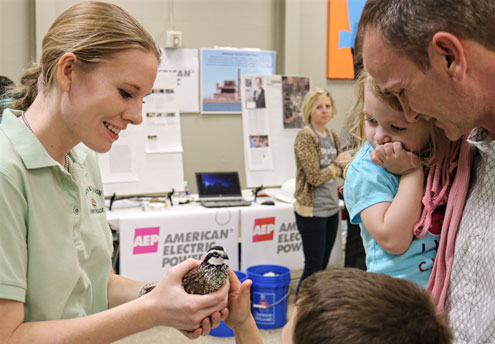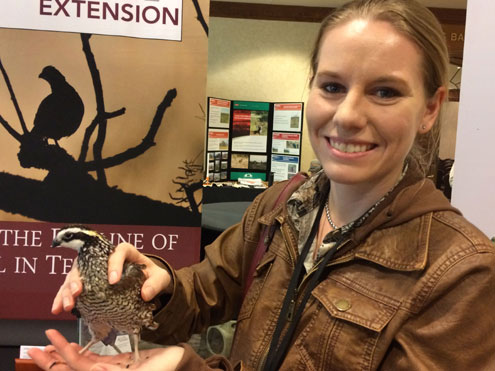A quail's tale...
College Station – One of the Texas A&M Natural Resources Institute’s most popular "spokespersons" for quail appreciation and conservation isn’t a person at all, but a sociable 6-inch-tall northern bobwhite named Kirby.
“We have been using Kirby as a ‘life model’ for a variety of educational programs and activities related to the conservation of quail and quail habitat,” said Dr. Jim Cathey, an associate director of the institute in College Station. “Texas is home to four quail species and quail are a vital part of the economy and ecology of the state. Unfortunately, the number of quail, especially northern bobwhite, has been declining for decades. Some possible causes are land use changes and land fragmentation, drought, habitat loss, predation, invasive species and disease.”

Cathey said the institute, which has offices on the Texas A&M campus in College Station and in San Antonio, as well as additional personnel based in Texas and other states, has an extensive wildlife conservation and mitigation program that helps address today’s wildlife and habitat management issues.
“We promote stewardship of wildlife populations, including game, nongame, endangered and threatened species and their habitats through the application and translation of sound science and outreach,” he said. “Among those outreach efforts is providing educational opportunities for youth and adults to better understand the challenges wildlife such as quail face in the wild — and what can be done to help them overcome those challenges.”
He said using Kirby as part of the institute’s educational component connects people with nature.
“A lot of youth and even adults, particularly in urban areas, may never have seen a quail,” he said. “Having Kirby during educational events provides an opportunity to talk about quail physiology and how quail are built to occupy a particular niche in nature.”

Cathey said quail have a short wingspan so they aren’t strong long-distance fliers; consequently, they spend much of their time on the ground. They also have large feet, which they use to scratch the ground to find food, like prairie chickens and other wild — and most domestic — fowl.
“Since most of their life is localized within a square mile or two, they are strongly affected by changes to their habitat,” he said.
Dr. Dale Rollins, retired Texas A&M AgriLife Extension Service wildlife specialist, San Angelo, has worked for more than five years on the statewide Reversing the Quail Decline in Texas Initiative and on other quail and quail habitat conservation initiatives for the past 35 years.
Rollins said a 2000 survey of more than 250 members of Quail Unlimited in Texas showed the average expense for a quail hunter is more than $10,350 per person, including travel, accommodations and lease fees. A 2012 follow-up survey showed only a small reduction in the amount spent.
“In many of the counties where there is quail hunting, smaller communities really depend on those hunters,” Rollins said. “So if there are an inadequate number of quail, the hunters won’t come, and their absence will have a significant negative economic impact on these communities.”
Rollins also noted in ecological terms quail can be thought of as the “canary of the prairie” in that they serve as an early indicator of problems with the habitat or ecology of the landscape.
“Quail are subjected to all sorts of predation by other animals and face many environmental challenges,” he said. “So if you have abundant quail on land that’s suited for them, then there’s likely been proper use and stewardship of that land. But if there aren’t many quail, that means the land likely also is not suited to and will not sustain an abundance of other species.”
Amanda Gobeli, institute associate based in Dallas, is Kirby’s keeper and caretaker and takes him to educational “gigs” throughout the state.
“Kirby was hatched from an egg a breeder provided and I was the first person he saw, so he imprinted on me,” Gobeli said, “He is basically a pet, staying in my house and interacting with the other birds in the household. He lives in a large enclosure lined with pine shavings. He has a jar with sand where he can take his dust baths. And he has a heat lamp. He eats a gamebird crumble, a nutritionally complete food, and he gets sunflower and chia seeds as treats. I also hide treats he has to scratch for, so he can use that natural food-finding behavior.”
She said Kirby has been around people since he was a chick, so he is comfortable interacting with and being handled by humans.
“He has been part of presentations at schools, quail appreciation events, and wildlife conferences and conventions throughout the state,” Gobeli said. “He’s always the star of the show when I do a presentation. Kirby gets people’s attention just by being there, and then sometimes he will whistle or do a covey call that draws people to him. He’s a big hit, especially with the kids.”
She said one particular question frequently asked about Kirby often leads to meaningful discussion about the many challenges quail face.
“Many people ask me how old Kirby is,” she said. “When I tell them he’s 3, I also add that, in the wild, the average life span for a quail is less than a year — and most of them never make it to their first breeding season. This usually leads into a meaningful conversation about the various reasons for quail decline and what can be done to help protect quail and quail habit in Texas. He’s a great ambassador for engaging people so we can start a dialogue with them.”
Gobeli said while estimates of how long quail live in captivity vary, she expects Kirby’s life span should be at least five years.
Dr. Maureen Frank, AgriLife Extension wildlife specialist in Uvalde, has presented at several events, lectures and conferences where Kirby has been shown. A few of the more recent events at which they appeared were the first-ever Urban Quail Appreciation Day last fall at the Witte Museum in San Antonio and a quail appreciation program last summer at the El Progreso Memorial Library in Uvalde.
“People are drawn to wildlife and it’s a unique and memorable experience for them to see wildlife in person,” she said. “Attendees may not remember everything about a presentation, but they’ll definitely remember seeing and interacting with Kirby.”
More information about habitat requirements of Texas quail can be found on the institute website at http://bit.ly/2D0ttX7